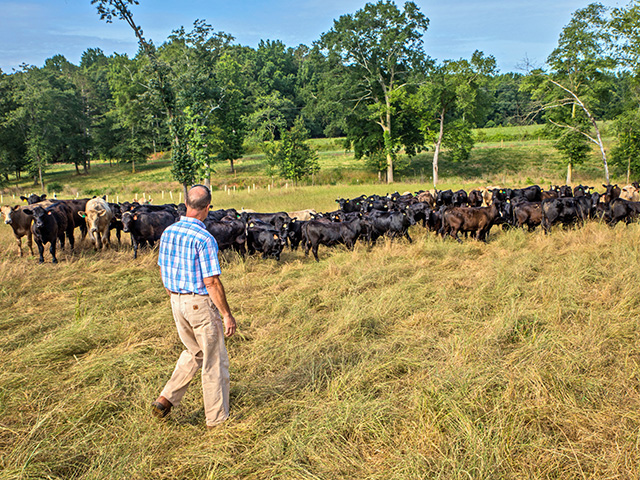Soil Born Again
Conservation - Soil Born Again
By the time Terry and Deborah Chandler bought their 200-acre Georgia farm in 1987, it was largely a spent, unproductive, brush-covered testimony to mismanagement. The Soil Conservation Service technicians of the day had been using the land as a bad example in teaching clinics.
"When we took over, the land was a wreck," Terry explains. "It had potential because there was only one way to go."
Terry Chandler, who was using his agronomy degree working for Seaboard Farms at the time, and Deborah Chandler, who holds a degree in plant pathology, saw a future for the farm, near Athens. "The land was in foreclosure and had been vacant for four years," Terry recalls. It was typical of farms that had been in continuous cotton production since the 1800s. The land once featured 12 to 14 inches of Madison/Davis clay loam topsoil but had been reduced to mainly red clay. Soil organic matter (OM) levels were under 1%, and fertility levels were nearly nonexistent. Still, there were hog-finishing facilities on the place, and the Chandlers, who also put up two pullet houses right after they took possession, saw an opportunity for a steady livestock income and a source of manure to rebuild the farm.
By finishing hogs and profiting from the poultry, the couple began to make financial progress. They built fences and established Tifton 44 and Russell bermudagrass pastures. "Having the manure from the livestock was huge in our rebuilding process," Terry says. "We not only started to improve our soil organic matter levels, but we could supply enough fertility to start to grow something."
P[L1] D[0x0] M[300x250] OOP[F] ADUNIT[] T[]
The Chandlers started a 60-head cow herd and put in underground lines to pump effluent with a traveling gun onto the pastures. "Things improved, but we were working ourselves silly," he says. Terry found answers to his labor woes when he attended a Georgia Grazing Lands Conservation Coalition meeting in 1992 and was introduced to management-intensive grazing.
EYE-OPENING
"The fundamentals they taught us seemed sound, so we set up three watering points and created 15 5-acre paddocks arranged in a wagon wheel fashion with single-strand Polywire," he explains. "What we saw from that single change in management was eye-opening. The improvements were almost immediately visible in forage response, animal performance and forage utilization."
After another grazing school and work with the Natural Resources Conservation Service, Terry put out 130 acres in paddocks with ample watering points for grazing flexibility. "We committed to manage the whole place with intensive rotational grazing and improve our forages to as close to 'year-round green' as we could," he explains.
The result is 25 years of steadily improved soil health and fertility levels, pasture carrying capacity and animal body condition. Through the steady use of cover-crop mixes and interseeding the bermudagrass pastures, Terry provides his cattle grazing nearly 300 days per year. He manages 25 paddocks of roughly 5 acres each, including nine 10-acre cells that can be divided in half, and stocks them at 75,000 to 100,000 pounds of animals per acre. "In the spring, we push the stocking rate to nearly 200,000 pounds, but throughout the year, we graze for forage height, and that means sometimes moving the cattle every 12 to 24 hours. During peak forage production, the herd can stay in a paddock three to four days," he says.
The Chandler farm is home to 100 Angus-Simmental cows that wean 650-pound or heavier calves per year, all backgrounded to 800 pounds. The pasture also hosts 50 to 100 stocker calves.
Meanwhile, as he improved his farm's production component, soil organic matter levels in Chandler's pastures have gone through the roof, ranging from 4 to 7% with some isolated samples showing 10% at times in annual soil samples. With the increased OM levels water percolation improves. Some soils can absorb 12 to 20 inches of rainfall per hour.
There is a nitrogen benefit. A percentage point of OM contains about 20 units of nitrogen (N). "With 5% OM, that's 100 pounds of N I don't have to buy," he says.
Another economic benefit of intensive rotational grazing was the elimination of most herbicide applications. "Rotation grazing causes a shift in pasture species. Weeds we once fought become forage to be consumed," Chandler says. "We save between $4,000 and $5,000 per year on weed control. Spot treatments are used for thistles and horse nettles."
Chandler now grazes his Bermuda from mid-May through October. On the last rotation in September, he uses an old 7-foot Tye drill to inter-seed a cool-season annual mix of cereal rye, ryegrass, vetch, daikon radish, crimson and other clover species. The stockpiled Bermuda grass takes Chandler into November. Fescue provides forage until the depth of winter. By the end of February Chandler's cattle are moving into the cool season annuals on the Bermuda pastures -- where they will remain as the warm season forage begins to grow in April and May.
"We're striving for plant diversity, but also diversity across species types," he says. "We want the different plant architectures and different rooting depths to continue our reclamation project."
[PF_0820]
(c) Copyright 2020 DTN, LLC. All rights reserved.




